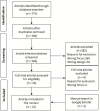Dynamic ambulance relocation: a scoping review
- PMID: 38101827
- PMCID: PMC10729233
- DOI: 10.1136/bmjopen-2023-073394
Dynamic ambulance relocation: a scoping review
Abstract
Objectives: Dynamic ambulance relocation means that the operators at a dispatch centre place an ambulance in a temporary location, with the goal of optimising coverage and response times in future medical emergencies. This study aimed to scope the current research on dynamic ambulance relocation.
Design: A scoping review was conducted using a structured search in PubMed, Scopus and Web of Science. In total, 21 papers were included.
Results: Most papers described research with experimental designs involving the use of mathematical models to calculate the optimal use and temporary relocations of ambulances. The models relied on several variables, including distances, locations of hospitals, demographic-geological data, estimation of new emergencies, emergency medical services (EMSs) working hours and other data. Some studies used historic ambulance dispatching data to develop models. Only one study reported a prospective, real-time evaluation of the models and the development of technical systems. No study reported on either positive or negative patient outcomes or real-life chain effects from the dynamic relocation of ambulances.
Conclusions: Current knowledge on dynamic relocation of ambulances is dominated by mathematical and technical support data that have calculated optimal locations of ambulance services based on response times and not patient outcomes. Conversely, knowledge of how patient outcomes and the working environment are affected by dynamic ambulance dispatching is lacking. This review has highlighted several gaps in the scientific coverage of the topic. The primary concern is the lack of studies reporting on patient outcomes, and the limited knowledge regarding several key factors, including the optimal use of ambulances in rural areas, turnaround times, domino effects and aspects of working environment for EMS personnel. Therefore, addressing these knowledge gaps is important in future studies.
Keywords: accident & emergency medicine; health services administration & management; organisation of health services; systematic review.
© Author(s) (or their employer(s)) 2023. Re-use permitted under CC BY-NC. No commercial re-use. See rights and permissions. Published by BMJ.
Conflict of interest statement
Competing interests: None declared.
Figures
Similar articles
-
Comparison of ambulance dispatch protocols for nontraumatic abdominal pain.Ann Emerg Med. 1995 Nov;26(5):579-89. doi: 10.1016/s0196-0644(95)70008-0. Ann Emerg Med. 1995. PMID: 7486366
-
Ambulance location and relocation under budget constraints: investigating coverage-maximization models and ambulance sharing to improve emergency medical services performance.Health Care Manag Sci. 2025 Jun;28(2):274-297. doi: 10.1007/s10729-025-09708-8. Epub 2025 May 21. Health Care Manag Sci. 2025. PMID: 40397332
-
Using genetic algorithms to optimise current and future health planning--the example of ambulance locations.Int J Health Geogr. 2010 Jan 28;9:4. doi: 10.1186/1476-072X-9-4. Int J Health Geogr. 2010. PMID: 20109172 Free PMC article.
-
Family & bystander experiences of emergency ambulance services care: a scoping review.BMC Emerg Med. 2023 Jun 14;23(1):68. doi: 10.1186/s12873-023-00829-3. BMC Emerg Med. 2023. PMID: 37316865 Free PMC article.
-
Utility of emergency call centre, dispatch and ambulance data for syndromic surveillance of infectious diseases: a scoping review.Eur J Public Health. 2020 Aug 1;30(4):639-647. doi: 10.1093/eurpub/ckz177. Eur J Public Health. 2020. PMID: 31605491 Free PMC article.
Cited by
-
Experiences of compassion fatigue among Generation Z nurses in the emergency department: a qualitative study in Shanghai, China.BMC Nurs. 2024 Aug 13;23(1):556. doi: 10.1186/s12912-024-02193-4. BMC Nurs. 2024. PMID: 39135166 Free PMC article.
References
-
- Bélanger V, Ruiz A, Soriano P. Recent optimization models and trends in location, relocation, and dispatching of emergency medical vehicles. European Journal of Operational Research 2019;272:1–23. 10.1016/j.ejor.2018.02.055 - DOI
-
- Nysam . Ambulanssjukvård. Nyckeltal 2019. rapport Maj 2020. In: English: Ambulance care. Statistics 2019. Report May 2020. Stockholm, 2020. Available: https://nysam.com/images/Rapporter/Ambulanssjukvard_2019_Nysamrapport.pdf
Publication types
MeSH terms
LinkOut - more resources
Full Text Sources
Medical

